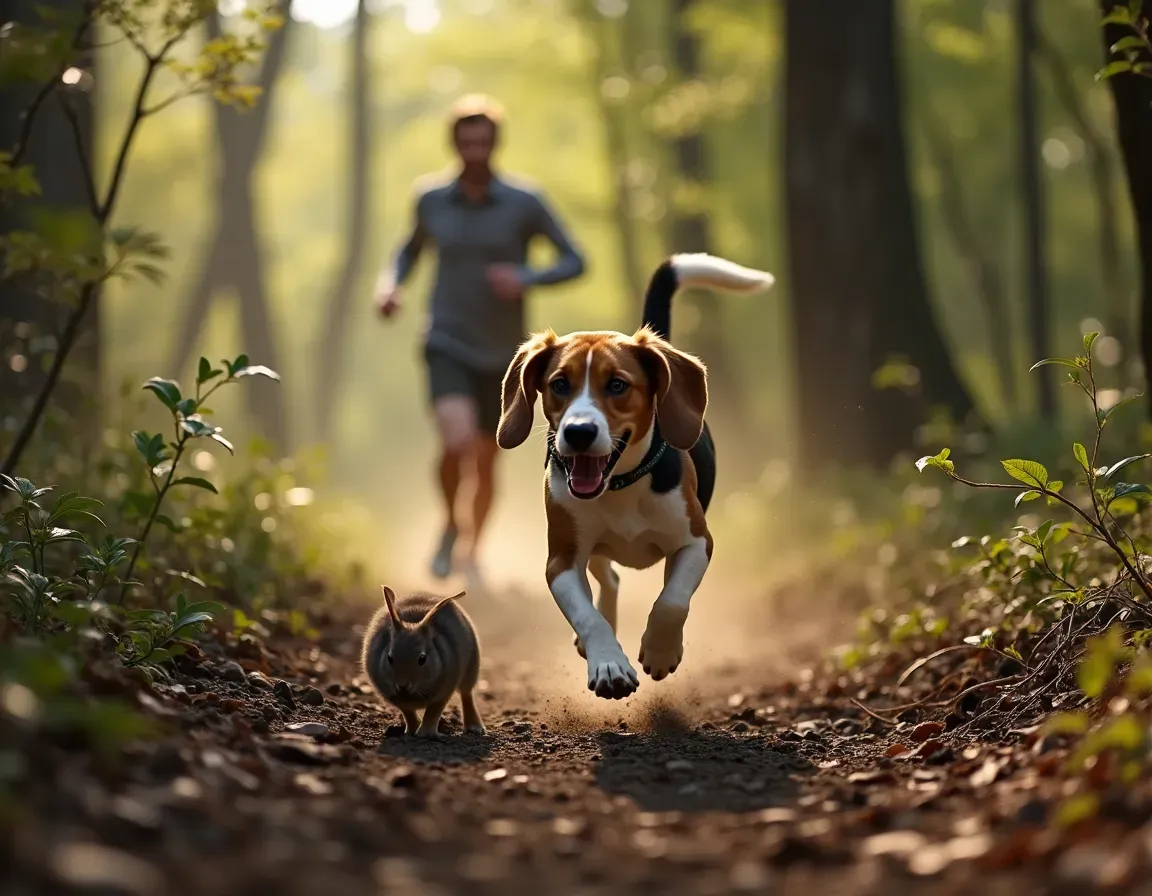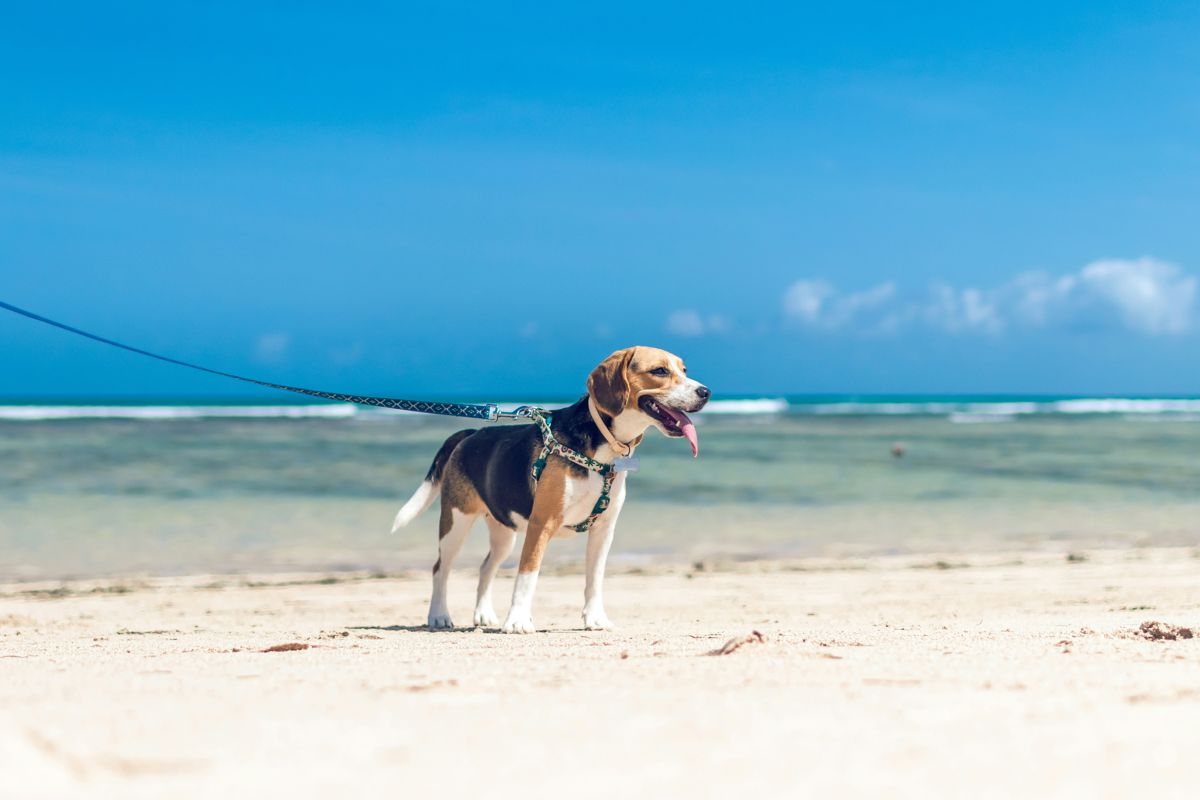The Beagle is a versatile dog, known both for its skills as a hunting dog and for its role as a family companion. With its cheerful character and exceptional scent, it is both a sought-after working dog and an affectionate companion.
However, before adopting a Beagle, it is essential to understand its characteristics, care, and needs to provide this dog with the most suitable living environment.
Origins of the Beagle #
The Beagle is an ancient breed that dates back several centuries. Developed in England, it was primarily used for hare hunting. Its exact origins are unclear, but it is certain that the Beagle was appreciated for its unparalleled scent, making it an excellent hunting dog. Today, it is widely adopted as a companion dog, although it is still used in some professional activities, such as scent detection.
Physical Characteristics of the Beagle #
The Beagle is a medium-sized dog with a muscular and robust body. Its drooping ears and short coat make it easily recognizable.
Size and Weight #
The size and build of the Beagle make it an excellent companion for hunting, but also for families with children: it remains small and light enough not to harm them inadvertently.
| Gender | Height (at the withers) | Weight |
|---|---|---|
| Male | 14 - 16 inches | 22 - 24 pounds |
| Female | 13 - 15 inches | 20 - 22 pounds |
Coat Color #
The Beagle has a dense and weather-resistant coat. From the most common to the least common, these different colors can be found in Beagles:
- Tricolor black, white, tan
- Bicolor white and lemon, white and brown or white and red
- Solid white (very rare)
This diversity of colors is a key visual characteristic of the breed.

Specific Features #
What primarily distinguishes the Beagle from other breeds is its extremely developed scent. Its exceptional sense of smell places it among the best detection dogs. Additionally, its compact size and robustness make it a dog well suited for long walks or hikes.
Behavior of the Beagle #
The Beagle is a friendly, dynamic dog often considered easy-going. However, it has a strong hunting instinct, which can make it stubborn at times.
Behavior with Children #
The Beagle is an ideal companion for children. Its playful character, combined with its patience, makes it an excellent playmate. However, due to its boundless energy, it is important to supervise its interactions with very young children to avoid any accidental harm.
Behavior with Other Animals #
The Beagle is generally sociable with other animals, especially with dogs. However, its hunting instinct can sometimes pose a problem with small animals like cats or rodents. Early socialization is therefore crucial to avoid any predatory behavior.
Health of the Beagle #
Life Expectancy #
The Beagle generally lives between 12 and 15 years, depending on its lifestyle, diet, and the quality of medical care it receives.
Common Diseases in Beagles #
The Beagle is generally a robust breed, but it is prone to developing certain diseases. Here is a summary table of the main conditions:
| Disease | Description | Frequency |
|---|---|---|
| Ear infections | Ear infections due to the drooping shape of the ears | High |
| Obesity | Excess weight that can lead to heart, joint, and diabetes complications | High |
| Hip dysplasia | Joint problems that can affect mobility | Medium |
| Hypothyroidism | Hormonal imbalance leading to a slowdown in metabolism | Medium |
| Eye problems (glaucoma, cataracts) | Conditions that can lead to vision loss | Medium |
| Patellar luxation | Displacement of the kneecap leading to limping | Medium |
| Epilepsy | Neurological disorders causing seizures | Low |
Training the Beagle #
Training a Beagle is both a challenge and an adventure. This intelligent but independent dog tends to follow its instincts rather than obey its owners. Therefore, it is crucial to structure its learning with appropriate methods while considering its curious nature and heightened scent.

✔️ Positive Training Methods #
Beagles respond very well to reward-based training methods. Here are some key principles to follow:
- Positive reinforcement: Reward good behavior with treats, petting, or play.
- Avoid punishments: The Beagle is sensitive, and punishment could harm your relationship. Prefer encouragement.
- Short and frequent sessions: Beagles can quickly lose interest, so it is better to have multiple short sessions.
- Use of treats: This dog being greedy, using treats to encourage it is often effective.
✔️ Importance of Early Socialization #
Socializing a Beagle from a young age is crucial to making it a well-balanced dog. To ensure optimal socialization, you can:
- Introduce different environments: Take it to various places (parks, busy streets, forests) to get it used to different sounds and stimuli.
- Meet other dogs: Encourage interactions with dogs of all sizes and temperaments.
- Introduce animals of other species: If you have cats or other animals, introduce them gradually to avoid hunting behaviors.
✔️ House Training #
House training a Beagle can be facilitated by following these steps:
- Establish a routine: Take the puppy out after meals, naps, and playtime.
- Reward immediately: As soon as the dog goes to the bathroom in the appropriate place, reward it with a treat or petting.
- Use designated areas: If possible, create a specific space in the garden or outside to encourage it to go to the bathroom in the same spot.
✔️ Teaching Basic Commands #
For your Beagle to be well-trained, it is essential to teach it basic commands. Here are the main ones to teach:
- “Sit”: A simple command that quickly captures your dog’s attention.
- “Lie down”: Useful for calming the dog in situations where it needs to stay still.
- “Come”: Essential outdoors, especially when it is distracted by a scent.
- “Stay”: Helps to control the dog when it needs to wait, for example, before crossing a road.
❌ Undesirable Behaviors #
Beagles can sometimes exhibit undesirable behaviors, often related to their hunting instinct or lack of stimulation. Here are some examples and tips to remedy them:
- Pulling on the leash: Their scent drives them to follow odors while pulling. Using a harness instead of a collar and teaching leash walking is essential.
- Frequent barking: The Beagle can be quite vocal. If barking becomes excessive, it is important to understand what triggers it (boredom, frustration, etc.) and respond accordingly.
- Running away: If the Beagle catches an interesting scent, it may be tempted to escape. Ensure your garden is well-fenced and regularly work on recall.
Examples of Training Exercises #
To keep your Beagle mentally and physically stimulated, you can incorporate these exercises into its daily routine:
- Recall outdoors: Very important with a Beagle, which can easily be distracted by a scent. Practice it regularly in varied environments.
- Scent search games: Hide treats or toys for it to find using its scent.
- Obstacle courses: If possible, use agility courses to tire it out and work on its obedience.
- Leash walking: Essential to avoid pulling, especially in scent-rich environments.
Character and Lifestyle of the Beagle #
The Beagle is a very active dog that needs a lot of exercise to thrive. Although it is affectionate and calm indoors, it requires regular outings.
Physical Activity and Exercise #
A Beagle needs daily walks and stimulating activities to avoid boredom. Interactive games or scent trails are particularly beneficial for this breed.
Indoor Character #
Indoors, the Beagle can be calm and affectionate, but it also needs toys and activities to avoid destructive behaviors, especially when left alone.
Character with Family and Other Animals #
The Beagle is very sociable and forms strong bonds with family members. It can live harmoniously with other animals, but this depends on its socialization.
Living Environment #
The Beagle can adapt to various living environments, as long as it has access to an outdoor space to expend energy. A house with a fenced garden is ideal for this breed. If you still wish to adopt a Beagle in an apartment, make sure to provide enough toys during your absences and at least 2 to 3 walks a day.

Care and Hygiene of the Beagle #
The Beagle is a breed that requires regular maintenance, although its grooming needs are not too demanding:
- Baths: The Beagle does not require frequent baths. A bath every 2 to 3 months is sufficient, unless it gets excessively dirty.
- Teeth cleaning: Teeth cleaning is important to prevent tartar buildup. It is recommended to brush your Beagle’s teeth at least twice a week.
- Ear cleaning: Due to the drooping shape of its ears, the Beagle is prone to ear infections. Regular ear cleaning with an appropriate solution is necessary to prevent infections.
Diet of the Beagle #
Diet plays a crucial role in the health and well-being of the Beagle. This breed is known for its voracious appetite and tendency to gain weight if not properly fed. A balanced diet, tailored to its age, weight, and activity level, is essential to maintain good physical condition.
Amount of Food #
The amount of food to give a Beagle depends on several factors, such as its age, weight, and activity level. Here are general guidelines:
- Puppy (up to 6 months): About 3 to 4 meals a day to support its rapid growth. The Beagle puppy should receive specific puppy kibble, rich in protein and fat.
- Adult (1 to 7 years): Two meals a day are generally sufficient. An adult Beagle should consume about 0.55 to 0.88 pounds of food per day, divided into two portions, depending on its exercise level.
- Senior (over 7 years): As physical activity decreases with age, the amount of food should be adjusted to avoid overweight. Senior dog kibble, lower in calories, is recommended.
Types of Food #
Feeding options for a Beagle can vary between kibble, wet food, or homemade diets. Here’s an overview of the main options:
- Kibble: Good quality kibble, rich in animal proteins, is ideal for ensuring complete nutritional intake. It is recommended to choose kibble specifically formulated for medium-sized dogs and with a good fiber content to support digestion.
- Wet food: Canned or pouch food can be given as a supplement to kibble or occasionally. It is more palatable but may contain more fats, so portions should be monitored.
- Homemade diet: If you opt for a homemade diet, it is crucial to balance proteins (lean meats), carbohydrates (rice, sweet potatoes), and fats, as well as to add essential vitamins and minerals. Consult a veterinarian to ensure your dog receives all necessary nutrients.
Overweight: A Common Problem in Beagles #
Beagles are predisposed to obesity due to their often insatiable appetite. Overweight can cause numerous health problems, including:
- Joint problems: Excess weight can put pressure on the joints, increasing the risk of dysplasia or arthritis.
- Heart problems: Obesity can promote cardiovascular diseases.
- Diabetes: An overweight Beagle is more likely to develop diabetes.
To avoid this, it is recommended to:
- Monitor portions: Adhere to the quantities recommended by the food manufacturer or your veterinarian.
- Avoid high-calorie foods: Limit treats and avoid giving table scraps.
- Encourage regular exercise: Daily walks and active play help maintain a healthy weight.
The care of the Beagle, while relatively easy, requires a minimum of attention, especially regarding diet!
Adoption and Cost of the Beagle #
Adopting a Beagle can represent a financial investment, but also a long-term commitment.
Price to Adopt #
The price of a Beagle varies depending on the breeder, pedigree, and location. On average, adopting a Beagle costs between $880 and $1,650.
Cost #
In addition to the adoption price, you should also consider the annual cost of owning a Beagle:
- Food: About $330 to $550, depending on the quality of the kibble or food chosen.
- Routine veterinary care (vaccinations, consultations, antiparasitics): About $110 to $330.
- Health insurance (optional but recommended): Between $165 and $440, depending on the chosen plans.
- Accessories (leashes, collars, toys, beds, etc.): About $110 to $220, depending on needs and necessary replacements.
- Grooming (baths, nail trimming): If you hire a professional, expect to pay about $55 to $110.
- Potential dental care or specific veterinary interventions: These costs can vary depending on the dog’s health status, but plan for additional amounts if health issues arise.
Ultimately, over the year, your Beagle will cost you between $660 and $1,650.

The Beagle, with its irresistible charm and playful temperament, is much more than just a hunting dog. Its energy, affection for children, and ability to adapt to different environments make it an excellent life companion. However, it is important to remember that the Beagle, while affectionate and sociable, requires rigorous training and regular activities to remain happy and healthy!

